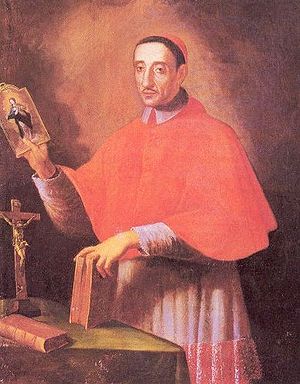He seems to me to want a year of great devotedness, intense sympathy and passionate love…Even one year of such a life would help a little, would help much to heal the wounds so many and so deep in His tender Heart. We must love Him and make Him loved more and more. He seems chiefly to ask complete abandonment to His pleasure, not lifting a finger to hinder His holy Will, but letting Him do with us exactly as He pleases.
COMMENT: Our new year’s resolutions should ultimately orient us towards serving God and others with greater dedication. Of course, a resolution written in such a manner would achieve very little as it if far too vague and is not capable of being measured. Instead we should try to develop resolutions based on particular areas of life where we are weak, for example resolutions to be more patient or to avoid gossip or to be more cheerful or to get up (and go to bed!) on time each day.
Today is the feast of St Giuseppe Maria Tomasi, a great reforming saint who lived in Rome in the 17th Century. His example seems to be an appropriate one to try to emulate for the year ahead. He was born into wealth and power, and his father was Prince of Lampedusa. St Giuseppe gave up his life of wealth and privilege to become a priest. He was noted for his learning and his scholarship and was made a cardinal. However, having been placed once more in a position of power, he strove to live with humility and poverty, teaching children their catechism and remaining dedicated to his studies. He is particularly noted for his work in the reform of the liturgy, in particular by being faithful to the ancient traditions of the Church.
In the lives of both St Giuseppe Maria Tomasi and Fr Doyle, we see shining examples of apostolic zeal and dedication to the duties of life. May they both pray for us as we attempt to emulate their virtues in the year ahead.
More information on St Giuseppe Maria Tomasi can be found here.


I found this part of the biography of St Giuseppe Maria Tomasi on the Vatican website very interesting:
‘In truth, not a few of the norms, established by the authority of the Roman Pontiffs and by the documents of the Second Vatican Council and today praiseworthily in use in the Church, were already proposed and ardently desired by Father Tomasi, among which it is sufficient to recall: the present-day form of the Liturgy of the Hours for the prayer of the Divine Office; the distinction and use of the Missal and of the Lectionary in the celebration of the Eucharist; various norms contained in the Pontifical and in the Roman Ritual; the use of the vernacular language, which he himself recommended in private devotions and in the prayers made in common by the faithful; all intended to promote a more intimate and personal participation of the People of God at the celebration of the sacred Liturgy.’
However,’the distinction and use of the Missal and Lectionary . . .’ seems to be a poor translation of the original Latin(?) and I’m not quite sure what it means. The present Liturgy of the Hours is much simpler than the old one, though there are many who still use the latter, including the monks of Silverstream Priory in the Diocese of Meath. And God bless them for that. One of the changes in practice that came with the reform of the Breviary after Vatican II was that the emphasis was put again on praying the different hours at the appropriate time of day or night.